$767,000 Decoy Tops Sotheby’s Americana Auction
January 24th, 2014
|
John James Audubon (1785-1851), Say’s Squirrel, inscribed in pencil: “2 female 1 male April 9 ’43 Female and male facing in long leaves of grass; St. Louis, MO,”watercolor, 14" x 19¾", 1831, tears, creases, and soil, sold on the phone for $137,000 (est. $80,000/120,000). The proceeds went to a nonprofit institution.
This circa 1900 eider drake decoy, maker unknown but probably from Monhegan, Maine, has a solid body with an inlet head and bill carving, and its original paint has minor wear. It is 8" high x 16½" long; it sold for $767,000 (est. $350,000/500,000). That price is the fourth-highest paid for a decoy. It was described in the catalog as “the most sophisticated of all eider decoys, with flowing lines and stylized abstract paint worthy of a Zen calligrapher” and “an unsurpassed expression of intuitive aesthetic genius, a bird portrait as expressive as the best of Audubon and a work of art worthy of comparison with any American painting or sculpture.” This decoy was part of the incomparable collection of Dr. James M. McCleery but was held back from the auction in 2000. It had never been offered for sale publically. The record for any decoy is $856,000, which was paid at a Christie’s and Guyette and Schmidt sale in January 2007 for a Lothrop Holmes red-breasted merganser hen.
This rare silver bowl by Thomas You of Charleston, South Carolina, circa 1765, circular, is on a stepped foot and has two incised bands below the rim and engraving on the base with contemporary block initials “I/I M,” and is marked on the base three times “T*Y” in oval. The 6" diameter bowl, 11 oz. 10 dwt., sold for $53,125 (est. $20,000/30,000) on the phone to New York dealer Tim Martin of S.J. Shrubsole, underbid by Brandy Culp, curator of Historic Charlestown Foundation, in the salesroom.
This circa 1796 profile portrait of Alexander Hamilton, a 9" x 7" pastel on paper by James Sharples (1751/2-1811), is in a molded giltwood and gesso frame. It sold on the phone for $23,750 (est. $10,000/15,000). The Sharples family toured the United States seeking to capitalize on the nationalist zeal. With assistance from his wife and children, Sharples produced a large body of portraiture depicting renowned figures of the Federal era.  Nineteenth-century American school watercolor and pen and ink on paper with mica on canvas, The Merrill Family in an Elegant Parlor, with original wood backing and period frame, 25" x 33½", circa 1830, sold to collectors in the salesroom for $50,000 (est. $20,000/30,000).
This Queen Anne salmon-painted maple chest of five drawers, attributed to Samuel Dunlap (1752-1830), Henniker or Salisbury, New Hampshire, circa 1800, appears to retain its original salmon paint and brass hardware. The 48" high x 40¾" wide x 20" deep chest sold in the salesroom to dealer David Wheatcroft for $75,000, underbid by dealer Peter Sawyer. According to Gerald W.R. Ward in American Case Furniture (1988), eight five-drawer chests were entered into Samuel Dunlap’s account book between 1785 and 1820. Characteristic of Dunlap school five-drawer chests, this example exhibits pad feet, cornice molding, and lipped drawers. The nearly identical chest in the Yale Gallery of Art collection has been furnished with replacement brasses and stripped of its original red paint, though according to Ward’s entry, traces of red paint remain. On the present example the brasses (with the exception of the bottom right brass, which is an early replacement) and paint are original. From the collection of Joanne and Jeffrey Klein, it was passed at Keno Auctions in 2013 at $180,000. According to the catalog it sold at a Richard Withington auction in 1975 and was bought by John Krapp, a collector from Henniker, New Hampshire. Wheatcroft said Wayne Pratt bought it at a 1997 Henry Berman & Sons sale in Henniker, New Hampshire, for $130,000 ($151,250 with buyer’s premium), underbid by Peter Sawyer. Pratt then asked more than $200,000 for it at the Winter Antiques Show in 1998 and sold it to the collectors who consigned it to Keno, where it failed to sell. It has appeared on the M.A.D. cover twice, in December 1975 and December 1997, highlighting each of those previous sales.
|
Sotheby’s, New York City
Photos courtesy Sotheby’s
Sotheby’s Americana Week auctions totaled $18.4 million, of which nearly $13 million came from the landmark sale of Ralph Esmerian’s collection (see M.A.D., March 2014, p. 30-D). Sotheby’s various-owners’ sale, held January 24 and 25, contributed just $5,451,076. Of the 428 lots offered, 284 found buyers, a sold rate of just 66.4% by lot.
There were some high points. An eider drake decoy from a rig probably made on Monhegan Island, Maine, circa 1900, sold for $767,000 (includes buyer’s premium) to dealer Arthur Liverant of Colchester, Connecticut, in the salesroom. It was the fourth-highest price ever paid for a decoy, topped by the Lothrop Holmes red-breasted merganser hen sold at Christie’s in partnership with Guyette and Schmidt in January 2007 for $856,000, A.E. Crowell’s feeding black-bellied plover sold by Guyette and Schmidt in November 2006 for $830,000, and an A.E. Crowell preening pintail drake sold by Christie’s in partnership with Guyette and Schmidt in January 2003 for $801,500. The eider drake was from the legendary Dr. James McCleery collection; it was the one bird kept by the family in Texas when Sotheby’s and Guyette and Schmidt sold the McCleery collection in 2000 for $10.9 million.
There was a round of applause in the salesroom when Philip Zea, president of Historic Deerfield, bought Asa Stebbins’s Federal inlaid mahogany tall-case clock for $185,000 (est. $150,000/250,000). The clock was made for Colonel Asa Stebbins, one of the wealthiest and most respected citizens of Deerfield, Massachusetts, at the time. His Federal brick house with Neoclassical furnishings and French wallpaper is a favorite in Deerfield. The clock will return there.
A small Boston canvaswork picture, a hunting scene with a dog, worked by Anna Woodbury (Swett), circa 1748, in pristine condition, sold for $185,000 (est. $150,000/250,000) to C.L. Prickett of Yardley, Pennsylvania, bidding on the phone from the Winter Antiques Show. An unfinished portrait of Jerome Bonaparte by Gilbert Stuart sold for $149,000 (est. $40,000/60,000) to a collector, underbid by a disappointed collector.
Prints, porcelain, and silver were offered in the first session on Friday afternoon. Most of the Audubon prints were bought by Arader Galleries.
Lily Arader, Graham’s daughter, did the bidding from her seat in the middle of the salesroom. She paid $46,875 (est. $15,000/25,000) for a Fish Hawk (Plate LXXXI) from Audubon’s elephant folio printed by R. Havell in London in 1830. She bought other Audubons under estimates: an Iceland or Jer Falcon (Plate CCCLXVI) for $56,250 (est. $60,000/80,000) and the Trumpeter Swan (Plate CCCVI) for $31,250 (est. $30,000/50,000). The Jaguar, dated 1846, printed by J.T. Bowen, from Audubon’s The Viviparous Quadrupeds of North America, went to Arader for $7500 (est. $6000/8000). A collector bidding on the phone paid $137,000 (est. $80,000/120,000) for John James Audubon’s watercolor of Say’s Squirrel.
Chinese trade porcelain performed poorly. Of the 53 lots offered, more than half failed to sell. A pair of Chinese export porcelain pistol-handled urns with covers, circa 1795, with some hairlines, sold to a collector in the room for $11,250 (est. $5000/8000) and was one of very few lots that sold over estimate.
The hundred or so lots of silver followed with mixed results. A group of ten Tiffany circus figures, circa 1990, sold for $16,250 (est. $8000/12,000) to an absentee bidder who left a bid with the auctioneer, and another group of eight circus figures went to the same bidder for $13,750 (est. $9000/12,000). John Ward, head of silver at Sotheby’s, said Russians and Australians as well as Americans are buying them.
Japanese export silver was largely ignored, but Tiffany flatware in the Japanese style was in demand. A set of Tiffany flatware, 68 pieces, in Lap Over Edge design, made 1880-90, including knives, forks, and spoons, decorated with squirrels, crabs, turtles, bats, beetles, and water lilies, sold for $53,125 (est. $20,000/30,000). Sixteen Tiffany coffee and ice cream spoons in the Japanese style sold for $8125 (est. $8000/12,000). A Japanese-style pitcher, in silver and silver gilt, the surface chased with a pond scene with applied irises, bamboo, catfish, and dragonflies, sold for $28,125 (est. $20,000/30,000), and a Tiffany New York Yacht Club trophy, with applied sea horses and seaweed, sold for $37,500 (est. $12,000/18,000).
The most active bidding was for a plain silver bowl made in Charleston, South Carolina, by Thomas You, circa 1765. It sold on the phone for $53,125 (est. $20,000/30,000) to Tim Martin of S.J. Shrubsole and was underbid in the salesroom by Brandy Culp, curator at the Historic Charleston Foundation. Martin said in his 18 years at Shrubsole he has never owned a piece of Charleston silver. Two silver urn-shaped Philadelphia tea services, one by Christian Wiltberger, the other by Abraham Dubois, failed to sell.
There was more interest in swords with silver hilts that were from the large collection of Dr. John K. Lattimer. The entire collection had been exhibited at Sotheby’s and offered in a private sale. When no one wanted to buy 100 swords, a dozen swords with clear marks of American silversmiths and provenance of identified American officers were offered. They provoked competitive bidding, and all of them sold. A silver-hilted lion-pommel cuttoe, carried by Colonel William Peck and made by John Bailey, Verplanck’s Point, New York, 1776-77, sold on the phone for $75,000 (est. $20,000/30,000), underbid by dealer James Kochan of Frederick, Maryland, who bought three other swords—a saber by William Ball of Baltimore for $6875, one by Jacob Kucher in Philadelphia with a knight’s head pommel and its original silver scabbard for $10,625, and a officer’s saber made by James Potter in New York, 1865-70, for $16,250. A collector in the salesroom bought three swords including a silver-hilted saber with an eagle pommel carried by Major John Griffith Johnston at Fort McHenry that was made by John Lynch in Baltimore, circa 1810, that sold for $26,250 (est. $20,000/30,000).
Of the 17 Oriental rugs offered, ten sold and only one hammered down over its low estimate: a Heriz carpet from Northwest Persia that sold for $28,125 (est. $20,000/30,000).
Much of the furniture sold at the low end of estimates. It seems that fastidious collectors are ignoring any piece with restoration, refinish, or aggressive estimates and are taking a very hard look, often with an advisor, at anything they want to buy. A collector in the salesroom paid $100,000 (est. $80,000/160,000) for a Boston cherrywood and marble-top pier table. The Stokes family circa 1765 Philadelphia Chippendale mahogany side chair sold for $87,500 on the phone to a collector and seemed like a bargain; on January 16, 1998, at Christie’s it sold for $178,500. A nearly identical pair of Philadelphia piecrust tea tables sold to a collector for $81,250 (est. $60,000/80,000). They came from the estate of Ted and Ingie Kilroy of Cleveland, who had paid $22,000 for one of them in 1981 and $10,000 for the other in January 1976.
Collector Linda Kaufman of Norfolk, Virginia, who has promised her collection to the National Gallery of Art in Washington, D.C., bought several lots from the Kilroy collection. She paid $15,000 for an inlaid walnut bonnet-top high chest of drawers made in Boston circa 1755 and $31,250 for another Boston bonnet-top high chest of drawers, circa 1765, for which the Kilroys had paid $21,000 back in 1977 at Sotheby’s before there was a buyer’s premium.
Kaufman paid $10,000 for a Philadelphia dressing table, $2375 for a New England cherrywood chest of drawers, $2125 for a mahogany looking glass with the label of William Wilmerding, New York, circa 1790, and $4063 for a pair of Chinese export porcelain Famille Verte lamps. This is a good time to buy.
Another collector in the salesroom paid $46,875 for the Kilroys’ five-legged New York games table with serpentine front and gadrooning but no carving. Another five-legged New York card table with no carving and no gadrooning and some condition problems sold later in the sale for $11,250 (est. $5000/6000). They are iconic forms, appealing without New York carving. A Maryland mahogany dressing table attributed to Gerrard Hopkins, carving probably by William Brampton, Baltimore, circa 1770, sold on the phone for $62,500 (est. $60,000/80,000). A Philadelphia piecrust tea table with an old surface but no carving sold on line for $22,500 (est. $20,000/40,000). A John Shearer desk (est. $40,000/60,000), inscribed on the back “Shearer/ Joiner/ Martinsburg,” was not quirky enough to sell; it was consigned by the High Museum of Art.
A Queen Anne salmon-painted maple chest of five drawers attributed to Samuel Dunlap (1752-1830), Henniker or Salisbury, New Hampshire, circa 1800, went to Westborough, Massachusetts, dealer David Wheatcroft for $75,000 (est. $50,000/80,000). “It sold at Dick Withington’s in 1975,” remembered Bill Upton, appraiser and consultant from Concord, New Hampshire. “Wayne Pratt wanted it in the worst way and raised $19,000 to buy it, a lot of money at the time. Wayne thought he had it when Withington turned to his best customer, John Krapp, sitting on the first row and asked, ‘You want it John?’ and John said ‘Yes,’ and he sold it to him for $20,000. In 1997 it came up again at a bankruptcy sale of John Krapp’s son in Henniker, New Hampshire. Pratt was determined to get it this time, and twenty-two years later he had to pay $130,000 for it. Exeter, New Hampshire, dealer Peter Sawyer was the underbidder at $125,000. Pratt advertised it in The Magazine Antiques, took it to the New York Winter Antiques Show, and asked a quarter of a million dollars for it, and he sold it.” It was offered at Keno Auctions in New York City in January 2013 where it passed at $180,000. This time it sold for $75,000. Wheatcroft said it was his best buy of the week. Peter Sawyer was again the underbidder.
For more information, contact Sotheby’s at (212) 606-7000 or (www.sothebys.com).
|
|
|
|
|
|
Originally published in the April 2014 issue of Maine Antique Digest. © 2014 Maine Antique Digest
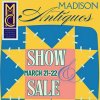



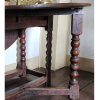



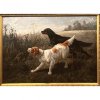





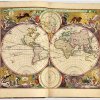


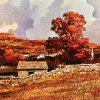
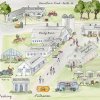





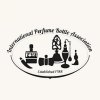
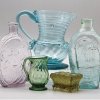









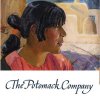





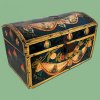





 This silver-hilted cuttoe with a lion pommel was carried by Revolutionary War Colonel William Peck and was made by John Bailey of Verplanck’s Point, New York, 1776-77. It sold to a phone bidder for $75,000, underbid by James Kochan in the salesroom.
This silver-hilted cuttoe with a lion pommel was carried by Revolutionary War Colonel William Peck and was made by John Bailey of Verplanck’s Point, New York, 1776-77. It sold to a phone bidder for $75,000, underbid by James Kochan in the salesroom. Rare Classical figured mahogany and églomisé paneled wagon-spring shelf clock by Joseph S. Ives (w. 1828-38), Brooklyn, New York, circa 1830, dial inscribed “
Rare Classical figured mahogany and églomisé paneled wagon-spring shelf clock by Joseph S. Ives (w. 1828-38), Brooklyn, New York, circa 1830, dial inscribed “ Chippendale carved and figured mahogany serpentine-front games table, New York, circa 1770, with its original card drawer, knee returns replaced, 27½" high x 34" wide x 17" deep, sold for $46,875 (est. $10,000/20,000) to an absentee bidder who left a bid with the auctioneer. On January 31, 1976, it sold at Sotheby’s for $8500 to Israel Sack, Inc. for Ted and Ingie Kilroy from Cleveland.
Chippendale carved and figured mahogany serpentine-front games table, New York, circa 1770, with its original card drawer, knee returns replaced, 27½" high x 34" wide x 17" deep, sold for $46,875 (est. $10,000/20,000) to an absentee bidder who left a bid with the auctioneer. On January 31, 1976, it sold at Sotheby’s for $8500 to Israel Sack, Inc. for Ted and Ingie Kilroy from Cleveland. Classical rosewood, brass inlaid, and ormolu-mounted worktable, Boston, Massachusetts, circa 1815, 29¼" high x 20 3/8" wide x 15½" deep, sold to a collector in the salesroom for $137,000 (est. $40,000/60,000), one of a very few pieces of furniture in the sale that doubled its high estimate. The catalog description read, “With its case veneered with brilliant flitches of rosewood and mounted and inlaid with brass, this worktable stands at the zenith of Boston Classical furniture design.” The Kaufman and Warner collections have two nearly identical surviving examples.
Classical rosewood, brass inlaid, and ormolu-mounted worktable, Boston, Massachusetts, circa 1815, 29¼" high x 20 3/8" wide x 15½" deep, sold to a collector in the salesroom for $137,000 (est. $40,000/60,000), one of a very few pieces of furniture in the sale that doubled its high estimate. The catalog description read, “With its case veneered with brilliant flitches of rosewood and mounted and inlaid with brass, this worktable stands at the zenith of Boston Classical furniture design.” The Kaufman and Warner collections have two nearly identical surviving examples.



